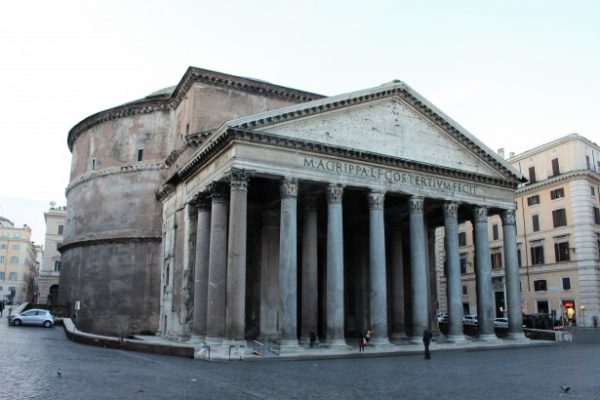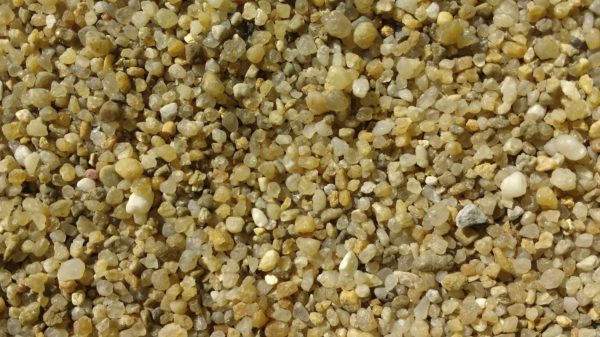Sand is so tiny and ubiquitous that it’s easy to take for granted. But in his book The World in a Grain, author Vince Beiser traces the history of sand, exploring how it fundamentally shaped the world as we know it. “Sand is actually the most important solid substance on Earth,” he argues. “It’s the literal foundation of modern civilization.”
Wherever we go, we’re surrounded by sand. It’s in the floors beneath us, walls around us and ceilings above us, plus the sidewalks and roads we use to get from place to place. Sand is a key ingredient in concrete, asphalt, and glass, not to mention the silicon chips inside our phones and computers. It is an essential component of modern life as we know it, yet, strangely enough, we are starting to run out.
“There’s a lot of sand in the world,” explains Beiser. “It’s actually the most abundant thing on the planet. But we are also using way more of it than ever before in human history. We use more sand than any other natural resource in the world except for air and water.” Humans use about 50 billion tons of sand each year. Of course, there is still plenty of it around, but not all sand is created equal, and much of it is effectively useless for construction. When it comes to desert sand, “the actual grains are shaped differently than sand grains that you find at the bottom of rivers or on beaches,” says Beiser. “It’s been eroded by wind rather than water over thousands and millions of years,” rendering it too round and smooth to be useful in creating robust concrete, which requires rough sand and aggregate to form proper bonds.
For much of metropolitan history, cities were built of materials like stone, brick, and wood. Ancient Romans developed a form of concrete, but after the fall of the Roman Empire, the technology was largely forgotten about. We stopped building with concrete until the 20th century, when a new development, reinforced concrete, took the world by storm. It became seen as a miracle material—malleable and durable, strong, and fireproof. Modern engineers appreciated its physical properties, using it to create roads, bridges and dams. Modernist architects, meanwhile, made use of these advantages, too, but also played with the flexible forms the material enabled, creating structures like the Guggenheim in New York and the Sydney Opera House.
But all that concrete requires sand, and the demand for sand has gotten so intense it’s causing problems. In some places good sand has become so scarce that the industry has begun to attract organized crime. People kill and get killed over sand. And the rate of urban development, particularly in Africa and Asia, means that that demand is not going away any time soon. “So to give you an idea,” says Beiser, “in 1950 there were about 750 million people worldwide living in cities. Today, there are more than 4 billion people living in cities … and tens of millions more pouring in every year. We’re adding the equivalent of eight New York Cities to the world every single year.”
The world will not literally run out of sand anytime soon, but sand extraction is increasingly causing huge environmental problems. In their quest for useable sand, people are doing a lot of damage to rivers, and lakes, and wetlands. Beiser compares the situation to another natural resource, oil. We’re not going to run out of either resource entirely, but extraction becomes more and more difficult as the resource dwindles, and the environmental impacts become more intense. “So the same thing that you see happening with oil,” as Beiser puts it, “where we’re having to do things like fracking and offshore oil drilling to get at the oil that’s left — similar kind of thing is happening with sand. We’re having to dig deeper and deeper and do more and more damage to get at the dwindling supplies of sand.”
Sand mining is not the only environmental impact associated with concrete. Creating concrete also adds huge amounts of carbon dioxide to the atmosphere. Covering surfaces in the material contributes to urban heat island effects, too — the concrete effectively traps solar heat, raising city temperatures. Concrete is also not porous, which is problematic when cities flood, an increasing concern in this era of climate change.
Some research is going into sand alternatives, like bamboo or recycled materials, which could be used in the creation of concrete. There are even fundamentally new materials being explored, like artificial rocks created by capturing atmospheric or emitted carbon, which could also be used in creating more sustainable concrete. Of course, even if these prove viable, producing alternatives in the quantities required to keep pace with global construction would still be a huge hurdle. In part, any well-rounded solution is going to involve the same elements as any scarce management resource: we need to find ways to use less of it, use it better, and in ways that will last longer.
Mass Timber
One of the most promising concrete alternatives is actually one of the oldest building materials on earth: wood. Instead of emitting carbon, wood captures and stores it. With wood, it’s even possible to create net carbon-negative buildings, which contain more carbon than their creation process emits. This requires sustainable approaches to growing and harvesting trees, but it also means using new and different types of wood products.
So-called “mass timber” products, created by recombining smaller pieces of wood, are increasingly being used in everything from bridges to skyscrapers. These can be assembled from scraps that would be individually unusable. Unlike old-growth timber construction, mass timber designs don’t require cutting down big trees, which means wood can be grown and harvested much faster, too. Using a lot of wood in new buildings has naturally raised concerns from some cities and their fire departments, which remember well the lessons of the last century, but through modeling and testing, engineers are increasingly convincing municipalities to amend their codes.
As it turns out, heavy composite timbers are surprisingly resistant to fire due to their thickness. Depending on the types and sizes of the supports, steel beams and columns can start to heat up and fail much sooner while wood chars more evenly and slowly. Like any building material, mass timber has its drawbacks, but as architects and engineers consider the environmental impacts of their projects, it offers another option in the material toolbox.
99% Invisible’s Impact Design coverage is supported by Autodesk. The Autodesk Foundation supports the design and creation of innovative solutions to the world’s most pressing social and environmental challenges. Learn more about these efforts on Autodesk’s Redshift, which tells stories about the future of making things across architecture, engineering, infrastructure and manufacturing, including more on mass timber construction.
Everything we manufacture has a hidden climate impact in the form of carbon emissions resulting from resource extraction, production, manufacturing, and logistics. We call this “embodied carbon”, and it can be hard to trace. Depending how it was made, one steel beam may have much lower embodied carbon than another one that looks and performs the same. EC3 reveals the embodied carbon of the materials going into our buildings, empowering architects, engineers, and contractors to make informed choices, selecting those materials that have the lowest environmental impact—providing transparency for a more sustainable built environment. To learn more and check out the EC3 for yourself, you can visit buildingtransparency.org










Comments (11)
Share
Solid show as always, thanks!
While you were discussing rebar and Ernest Ransome I was waiting for the callback to episode 81.
I noticed that a lot of this episode was dedicated to pointing out the problems that other countries have, while precisely skirting around talking about American consumption. There was some discussion, but the discussion included many positive qualities, a trait that the other countries weren’t afforded. I personally will find myself frustrated in many episodes with the way that 99 Percent Invisible will handle discussion of other countries. There is a lot of positive representation in a lot of episodes as well, and that’s really important, and it’s appreciated. However, when 99 Percent Invisible does not directly address issues that the USA has, ones that seriously impact the story that 99PI is telling, the show feels flat, shady, and Ameri-centric. That isn’t an additude that should be passively accepted/moderately adopted.
Why dont Sand Miners get their sand from the ocean floor? Of course you would have to find a good balance where it is far ebough offshore but not too deep so that the soil isnt sand anymore. Also you would need to find a spot with not alot of endangered sea life. But based on the amount of sand needed the ocean would be a great source, also with rising sea levels it may help mitigate that problem by lowering sea levels by taken out all that sand.
There is also an developing movement aimed at a fundamental re-imagining earthen based construction material as a basic multi-dimensional (structural, thermal resilience, IAQ) low-carbon material.
Loved this episode!
Only issue I had is when he talked about Americans would be happier with less. I like my house, and worked very hard to achieve it.
Otherwise, I really love the show.
Re mass timber construction, I’m wondering what material is used to fuse/glue the layers of wood together to create the large structural pieces. The podcast mentions only the use of “massive pressure”, but I’m pretty sure there is adhesive involved; like plywood manufacture, on a larger scale. What’s the environmental impact of production and use of that adhesive; and does it have an effect on the fire-resistant characteristics of the finished mass timber structural element?
It appears that researchers at the MIT just came up with a way to avoid carbon emissions during cement production, using an electro-chemical process:
http://news.mit.edu/2019/carbon-dioxide-emissions-free-cement-0916?fbclid=IwAR1ExZG-32Aad3a4ml4um_6YoyQdkrh8owdeZI_nO6mVgYNbFLcTJ7w0MS8
Still, that doesn’t help with the environmental damage done by sourcing sand…
I also understand modern concrete has a very short life due to the rusting of the steel rebar…..
how did the romans manage to built with concrete that is so long lasting?
Seeing this image of a sand diver reminded me of this story. http://www.philipleeharvey.com/journey/2010-sand-diver-niger-river-mali/
Some fun facts about hempcrete. When lime is used as a binder (rather than cement) it tales 80 percent less energy to calcine, and the lime cured by reabsorbing the Co2 that is driven off. It is essentially reconstituted limestone with a biologically renewable aggregate–not sand, (Though sand is used in the plaster finishes.)
Hempcrete cant replace concrete for foundations and dams and all, but think of all the places in the world where above ground walls are made of concrete. Because it was cheap. Hempcrete would be safer in earthquakes, permits humidity to pass through, it insulates, is fireproof, mold resistant, and has superior aesthetic and acoustic qualities.